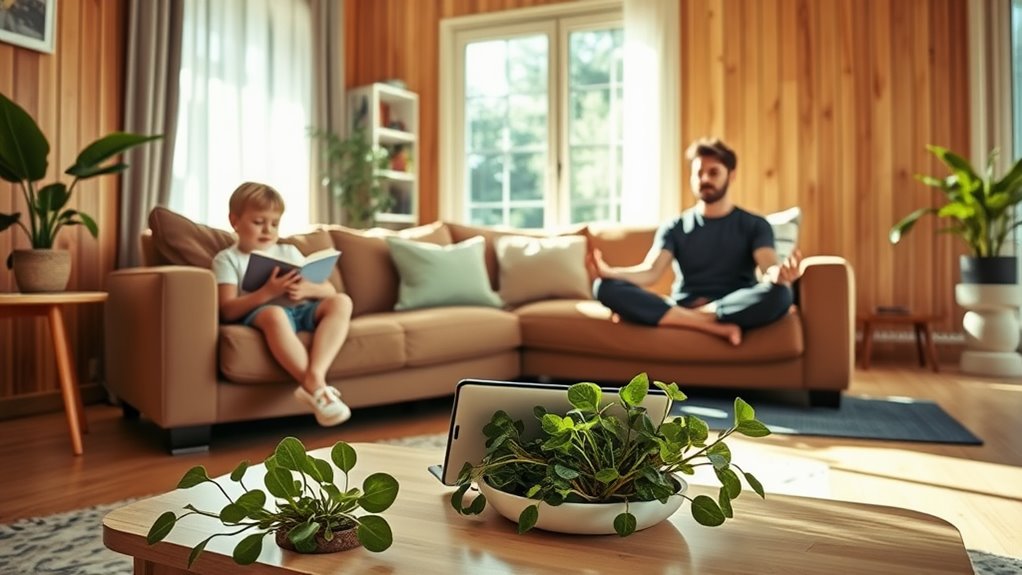Top Strategies for Managing Screen Time in a Digital World
To manage screen time in today’s digital world, start by setting clear limits for device use, tailored to family needs. Create tech-free zones in your home, like during meals, to promote quality time. Utilize screen time tracking tools to monitor usage and identify patterns, helping everyone stay accountable. Prioritize offline activities by exploring hobbies or planning family outings. Lastly, practice mindful technology use by focusing on meaningful interactions rather than passive consumption. By adopting these strategies, your family can enjoy a healthier balance with screens, and there’s much more insight to explore on enhancing digital well-being.
Key Takeaways
- Set clear screen time limits for family members, incorporating designated times for homework, chores, and leisure activities.
- Establish tech-free zones in your home to promote quality interactions and shared experiences without devices.
- Utilize screen time tracking tools to monitor usage patterns and set daily limits for individual devices or apps.
- Prioritize offline activities by engaging in creative hobbies or planning regular outings to strengthen family bonds.
- Practice mindful technology use by promoting intentional engagement and assessing the alignment of device usage with personal values.
Set Clear Screen Time Limits
Setting clear screen time limits is essential for maintaining a healthy balance in your daily routine. Establishing screen time agreements with your family can help everyone understand the expectations and boundaries around device usage.
Start by discussing how much time each person thinks is reasonable for recreational screen time, considering factors like age and daily responsibilities.
Once you’ve settled on a fair amount, incorporate these limits into your family routines. For example, you could designate specific times for homework, chores, and leisure, ensuring that screen time doesn’t interfere with other important activities.
Setting a timer can also create a sense of accountability, making it easier for everyone to stick to the agreements you’ve made.
Don’t forget to check in regularly to see if the limits are working for everyone. If necessary, be open to adjusting the agreements as your family’s needs change over time.
Establish Tech-Free Zones
Creating tech-free zones can significantly enhance your family’s connection and reduce the distractions that screens often bring. Establishing these zones in your home is a simple yet effective way to encourage quality time together.
Consider designating areas like the dining room or family lounge as tech-free spaces where everyone can engage in conversation, play games, or simply enjoy each other’s company.
You might also want to set specific times for family game nights, where everyone puts their devices away and focuses on bonding through fun activities. This not only strengthens relationships but also creates lasting memories.
Additionally, think about incorporating outdoor adventures into your routine. Whether it’s hiking, playing sports, or having a picnic at the park, these tech-free experiences allow you to connect with nature and each other without the interference of screens.
Utilize Screen Time Tracking Tools
Tracking your family’s screen time can be a game changer when it comes to managing device usage. By utilizing screen time apps, you can gain valuable insights into how much time everyone’s spending on their devices. These tools provide usage analytics that help you identify patterns and trends in screen time, making it easier to set limits and establish healthy habits.
Many screen time apps allow you to set daily limits for individual devices or specific apps. This way, you can ensure that screen time doesn’t spiral out of control. You’ll also have the option to receive notifications when someone is nearing their limit, helping create accountability within the family.
Moreover, these apps often include features like app categorization, which lets you see how much time is spent on educational versus recreational activities. This information can help foster discussions about appropriate screen time and encourage family members to make mindful choices.
Prioritize Offline Activities
Making time for offline activities is essential for balancing screen time in your family’s daily routine. By prioritizing these activities, you can foster stronger relationships, creativity, and well-being.
Start by encouraging your family to explore creative hobbies together. Whether it’s painting, gardening, or crafting, these pursuits not only stimulate imagination but also provide a fulfilling break from screens.
Don’t forget the importance of family outings. Plan regular trips to parks, museums, or local events that interest everyone. These outings can create lasting memories and offer a refreshing change of scenery. You might even consider setting aside one day a week for a screen-free family adventure, allowing everyone to reconnect with each other and the world around them.
Additionally, incorporating offline activities into your daily schedule can help establish healthy routines. Designate specific times for creative hobbies or outdoor play, making it a non-negotiable part of your family’s lifestyle.
Practice Mindful Technology Use
In today’s digital age, finding a balance between screen time and mindful technology use is crucial for maintaining a healthy lifestyle. You can start by practicing mindful consumption—this means being aware of how much time you spend on devices and what you’re engaging with.
Instead of mindlessly scrolling through social media, take a moment to reflect on whether that content truly enriches your life or just fills time. Intentional engagement is key here. Set specific goals for your technology use, like limiting social media to 30 minutes a day or only checking emails during designated times.
When you do engage with technology, do so with purpose. Ask yourself if the activity aligns with your values and contributes positively to your well-being. Additionally, consider using apps that track your screen time to help you stay accountable.
By prioritizing meaningful interactions over passive consumption, you’ll likely find that your overall satisfaction increases. Remember, it’s not about eliminating technology completely; it’s about finding a healthy balance that enhances your life rather than detracting from it.
Embrace mindful technology use, and you’ll cultivate a more fulfilling digital experience.
Educate on Digital Well-Being
A growing awareness of digital well-being is essential in today’s tech-driven world. By educating yourself and those around you about the importance of digital literacy, you can foster a healthier relationship with technology.
It’s not just about limiting screen time; it’s also about understanding how to use technology mindfully.
Here are some key aspects to consider:
-
Understand the impact of screen time: Recognize how excessive use can affect your mental and physical health.
-
Promote mindful consumption****: Choose quality content that enriches your life rather than mindless scrolling through social media.
-
Encourage open discussions****: Talk about online experiences, sharing both positive and negative impacts, to foster awareness.
-
Set boundaries: Establish clear personal or family rules regarding device usage to maintain a balanced life.
Frequently Asked Questions
How Does Screen Time Affect Mental Health in Children?
Imagine a child’s laughter fading behind a glowing screen; excessive screen time can cloud their mental health, causing anxiety and loneliness. Balancing digital play with real-life connections is vital for their emotional well-being.
What Are Signs of Screen Addiction in Teenagers?
If you’re noticing warning signs like irritability or anxiety when screens are unavailable, or behavioral changes such as neglecting responsibilities and decreased social interaction, it might be time to reassess your teen’s screen use.
Are There Age-Specific Screen Time Recommendations?
Yes, there’re age-specific screen time recommendations. These guidelines consider developmental impact, suggesting limited screen use for younger children, while teens can have more time, but balance is key to ensure healthy development and engagement with real-life activities.
How Can Parents Model Healthy Screen Habits?
To cultivate a garden of healthy habits, you can embrace screen-free activities during family routines. Share stories, play games, or explore nature together, showing your kids that life beyond screens is vibrant and rewarding.
What Are the Benefits of Reducing Screen Time?
Reducing screen time boosts cognitive development, allowing you to engage more in creative activities. It also enhances family bonding, as you share experiences and conversations without distractions, fostering deeper connections and a healthier home environment.





